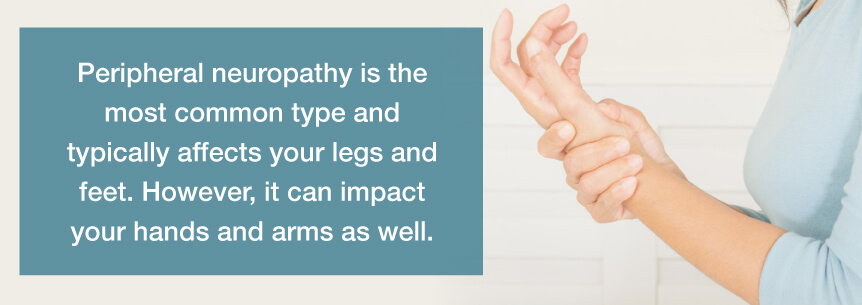
Diabetic neuropathy is nerve damage caused by recurring high blood glucose. It is among the most debilitating and frustrating diabetes complications due to the discomfort, pain and disability it causes. Even worse, many of the available treatments aren’t systematically successful. However, you might find relief from these debilitating symptoms with medical marijuana for diabetic neuropathy.
Medical marijuana is a helpful anti-inflammatory therapy and does not risk the same side effects as steroids, which diabetics are supposed to always stay away from. Due to the fact arterial inflammation usually occurs during a diabetic’s life, cannabinoids are of great use to those who need an alleviator. Medical marijuana also treats patients with its neuroprotective properties, which means it will help protect nerve covering from inflammatory attacks caused by glycoproteins in the blood.
Find A Doctor Find A Dispensary

Use marijuana and diabetic neuropathy treatment to alleviate symptoms such as:
The University of California at San Diego conducted a recent, controlled and randomized study showing inhaling medical weed can calm pain from diabetic neuropathy for a few hours without severely impairing cognitive function. Individuals experienced more relief the more concentrated the dose was.
You have cannabinoid receptors throughout your brain, nervous system nerves, spinal cord and on inflammatory cells, according to the study’s lead author. When you stimulate these receptors, it leads to decreased inflammation and pain relief.
Another smaller 2010 study showed one inhalation of 25mg of 9.4 percent THC herbal marijuana a few times each day for five days improved sleep, decreased pain intensity and patients tolerated it well.
Below are only some of the many marijuana and diabetic neuropathy strains you can find relief from based on their terpene profiles, chemical makeup, THC-to-CBD ratios and cannabinoids.
Strains best for inflammation and neuropathic pain include:
Strains best for treating condition-related depression include:
If you’re experiencing inflammation and chronic pain, you already know how pain can sneak its way into every aspect of your life. Depression can also affect you as you’re trying to cope with the pain and it can often be as debilitating as pain.
Cannabis and diabetic neuropathy smoke contain many inorganic and organic chemical compounds — close to what you find in tobacco smoke. When you smoke, no matter what substance, you risk your health because of the carcinogens in the smoke.
Fortunately, you can ingest your marijuana and diabetic neuropathy treatment without smoking. This removes the need to inhale the toxic compounds smoke creates and thereby cancels out the respiratory harm risk linked to smoking. Several delivery methods of medical marijuana for diabetic neuropathy treatment include:
You might also find medical marijuana topicals you can rub on your feet to experience relief.
If you’ve had enough dealing with your diabetic neuropathy pain and you’re not getting the relief you need, perhaps it’s time for you to start your medical cannabis treatment for your diabetic neuropathy symptoms.
Take some time to explore the abundant resources here at MarijuanaDoctors.com and browse around for a bit. Soak in all the valuable information on this miracle herb and then search for a medical marijuana doctor and find a cannabis dispensary near you. We’re ready to help you realize the full therapeutic benefits of medical marijuana.
Find A Doctor Find A Dispensary
Diabetic neuropathy is a form of damage to your nerves occurring with diabetes. When your glucose (blood sugar) is too high, it may injure your body’s nerve fibers, but this condition damages the nerves in your feet and legs. Depending on which nerves are affected, diabetic neuropathy symptoms may range from numbness and pain in your extremities to more serious issues in your:
Some individuals’ diabetic neuropathy presents only mild symptoms, but for others the condition can be disabling, painful and even fatal in some rare forms. Diabetic neuropathy is a severe diabetes complication, but you can slow its progression or even prevent it with a healthy lifestyle and rigid blood glucose control.
Numerous things can lead to the development of diabetic neuropathy. When your blood sugar is too high, it can interfere with your nerves’ ability to transmit signals. High blood sugar can also weaken the walls of your capillaries (small blood vessels) that provide your nerves with nutrients and oxygen. Other potential causes of diabetic neuropathy are:
Doctors use the term neuropathy to describe a few different types of nerve damage. With diabetes, you have the risk of developing four primary neuropathy types:

Diabetes’ first recorded case appears on papyrus. Egyptologist Aaron Eber found it in Thebes in an ancient grave. The papyrus is in hieroglyphs writing and is estimated to have been written in 1550 BC.
These ancient records don’t seem to reference its nervous system complications. Western physicians began studying diabetes in the 18th century along with the disease’s complications. Finally, 19th-century works showed the association between diabetic neuropathies and diabetes mellitus. The 1921 insulin discovery triggered more inspiration to research diabetic complications and a better systematic approach.
Diabetic neuropathy symptoms vary and depend on the nerves affected and the type of neuropathy you have. Therefore, the symptoms below align with the type of neuropathy they’re associated with. With peripheral neuropathy, you may experience:
For autonomic neuropathy, symptoms may include:
Radiculoplexus neuropathy (diabetic amyotrophy) can present symptoms like:
Usually, symptoms appear on one side of your body. However, they can move to the other side in some cases.
Mononeuropathy symptoms depend on the involved nerves and may include:
In some cases, mononeuropathy occurs with a compressed nerve. For instance, diabetics tend to have carpal tunnel syndrome.
Besides the tingling, numbness, lack of feeling and pain, numerous serious complications can arise with diabetic neuropathy, including:
Charcot joint is where you have a deteriorated bone, typically in your foot, due to damaged nerves.
Since damage to your nerves may lead to your losing feeling in your feet, you may not notice sores and cuts and they eventually become ulcerated or infected. Since diabetes decreases the flow of blood to your feet, you have a higher risk of infection. Infections may spread to your bone, causing gangrene (tissue death) which is untreatable in nearly all cases and requires amputation of your foot, toe or your entire lower leg.
Digestive system nerve damage can lead to diarrhea or constipation — or both alternating back and forth. Digestive problems may also cause:
Gastroparesis may occur and interfere with digestion and lead to bloating, nausea and vomiting as well. It can also affect your nutrition and blood sugar levels severely.
Autonomic neuropathy can cause nerve damage potentially affecting the sex organs of both men and women. While men struggle with erectile dysfunction, women can experiences problems with arousal and lubrication.
Specific nerves control your body’s circulation. When damage occurs to these nerves, it affects how your body adjusts to blood pressure.

Your diabetic neuropathy prognosis will depend on how effectively you treat your diabetes. Once you receive diabetes treatment, it may improve your symptoms and stop your neuropathy progression. For some patients, the painful sensations associated with diabetic neuropathy get so severe they lead to depression. The severity of pain in diabetic peripheral neuropathy is associated with:
Diabetic neuropathy pain significantly affects patients’ quality of life. In a study, diabetic neuropathy patients reported the pain was so bad it resulted in significant interference in:
These patients were being compared with non-diabetic neuropathy patients.
Facts associated with diabetic neuropathy according to the National Center for Biotechnology Information (NCBI) include:

Diabetic neuropathy has no cure, but doctors can slow its progression with treatment. Medical attention helps ease and manage your symptoms, particularly your pain. By maintaining a healthy blood sugar level range, you can slow down neuropathy progression and alleviate some of your symptoms. Exercising regularly and quitting smoking can and should also be part of your treatment plan.
Your doctor can prescribe certain medications to help reduce your diabetic neuropathy-related pain. Pregabalin (Lyrica) is a conventional medication prescribed to patients who have diabetic neuropathy. In some cases, your physician may recommend you take anti-seizure medications for nerve pain. If you’re depressed because of your neuropathy, you might need to take an antidepressant. You’ll want to discuss these medications with your doctor as well as their potential side effects.
Alternative therapies for pain, like acupuncture and dry brushing, may help. Some individuals find they do offer some relief when combined with medication.
If you’re experiencing digestion problems due to your neuropathy, the physician may recommend you change your diet a little by:
Your doctor may prescribe you lubricants if you’re a woman experiencing vaginal dryness. There are also medications the doctor can prescribe for male erectile dysfunction.
In the U.S., one of the primary reasons for lower-leg amputation caused by a non-traumatic event is diabetes. Therefore, pay particularly close attention to your feet and take good care of them if you have peripheral neuropathy.